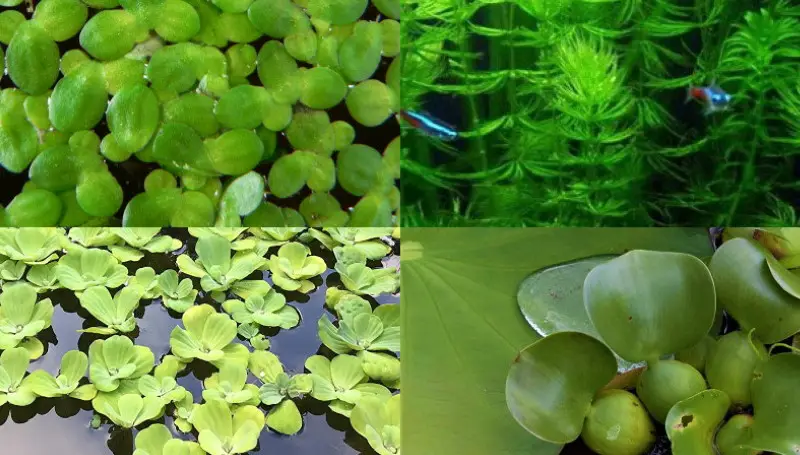Floating plants, they’re a bit of an opinion divider in the aquarium hobby. Personally, I love them. But, trying to stay objective, they do have their pros, and they have their cons.
For example, floating plants are great because they provide shade and cover for your nervous fish. This will mean any skittish fish you might have in you tank will be more active and confident in their behavior. They can also help discourage known “jumpers” from leaping out of the water and onto the carpet below.
Conversely though, the shade from your floating plants that some of your fish might absolutely love, will block the light from reaching any of your rooted plants growing deeper in the water column.
Types Of Floating Plants
I like to divide floating plants into two types.
First are the plants where the leaves are above or floating on the surface of the water, while the roots trail down into your tank. The advantage for this type of floating plant is that the leaves have access to the CO2 in the open air and as such can grow very quickly without you needing to add CO2 to the water. Because they can grow so fast, they’re great for removing nitrogen from your aquarium. However, to keep this type of plant you’ll need a bit of clearance between the surface of the water and the lid and/or light fixture above.
The other kind of floating plant is the kind that exists entirely below the surface. So, these types have no issues with surface clearance. But, on the other hand, they get all of their CO2 from the water column. Therefore, they might grow a bit slower.
Water Hyacinth
Water hyacinth has leaves above water, and long roots that trail down in the water.
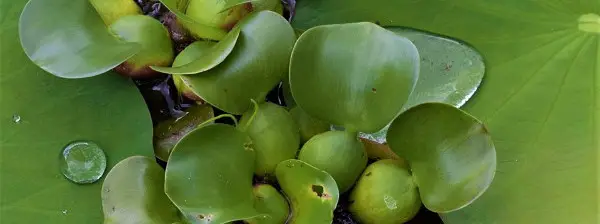
This is a super fast grower. So it won’t be long before it covers the top of your aquarium or your pond. Its roots are great for baby fish to hide among. They also provide a surface for micro organisms and detritus to build up on, and again, this is a benefit for your fish fry—because they’ll be able to nibble on the stuff.
Although, the roots to this plant are not to everybody’s taste. Not only are they long and thick, but they are dark in coloration, almost black. Most plants tend to have white roots, so for this reason the water hyacinth really sticks out. Whether you do or don’t like the black roots though, is a matter of personal preference.
The water hyacinth is just as interesting looking above the water. In addition to its lovely green leaves, it also has little air sacks that help it float on top of the water—very cool!
How does this plant propagate? Like most floating plants, it reproduces as it grows. Water hyacinths send out runners which then grow new daughter plants which can be split from the parent plant and grown independently.
Amazon Frogbit
Amazon frogbit has leaves that float on the surface, and roots that exist below the surface.
Like the water hyacinth, Amazon frogbit is also a fast grower. And fast growers are always great for nitrogen removal!
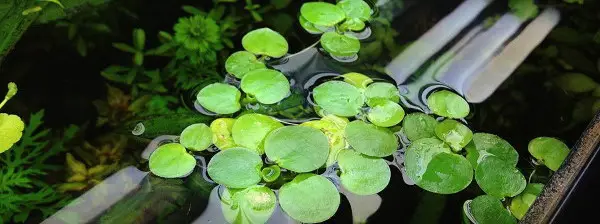
Compared to some other floating plants, Amazon frogbit has tiny roots. So, if you don’t enjoy the long trailing roots of some other floating plants, then maybe Amazon frogbit is for you. The roots are a sort of greenish white color.
Too much surface agitation can be a problem for frogbit, as when the leaves get wet on their upward facing side, they tend to suffer. So, you might find bunches of dying frogbit near any airstones you’re running or near your filter return.
Water Lettuce
Water lettuce is also known as pistia. Its leaves have an interesting texture to them, they almost feel like fuzzy terrestrial lettuce leaves. Its from this similarity to common lettuce that the plant gets its name.
Like frogbit and water hyacinth, the leaves are above the water and the roots below.

Sadly, water lettuce is probably too large for the average aquarium. It grows a few inches above the water level so you simply might not have space between the surface of your water and your aquarium lid or lighting.
However, if you can grow it in your tank—perhaps by lowering the water level or removing the lid—it’s definitely worth it.
Water lettuce grows like lightning, it won’t be long before it covers your entire aquarium. And, what do we keep saying about fast growing plants? They’re awesome nitrogen suckers. Because they grow so fast, they’ll pull just about any ammonia, nitrite, or nitrate out of your water which in turn reduces the number of water changes you need to do.
Its roots are large and long, like the water hyacinth, but they’re lighter in color and aren’t quite as thick. So, if you prefer that particular aesthetic then this could be the floating plant for you.
Hornwort
Hornwort is a bushy stem plant that grows very quickly.
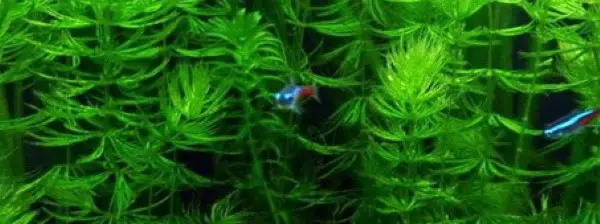
Unlike the other floating plants we’ve covered so far, this plant grows entirely under the water. The fact that it grows entirely underwater is even mentioned in its scientific name: ceratophyllum demersum. “Demersum” means underwater.
You can anchor this plant in your substrate if you want, but I enjoy it best as a floating plant.
One noteworthy claim concerning hornwort is that it inhibits cyanobacteria (also known as blue green algae).
Elodea
Like hornwort, elodea is another great floating plant that does all of its work entirely beneath the surface of the water. And again, like hornwort, you can leave your elodea to float or you can plant the stems in your aquarium’s substrate if you wish.
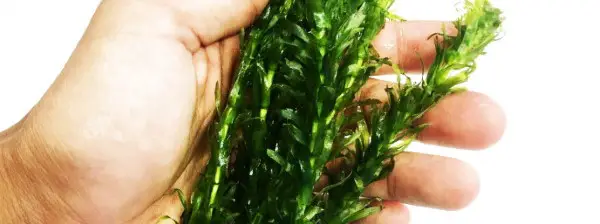
Elodea is a genus with a number of species in it, and those species tend to be lumped together by the casual hobbyist. It also has a lot of different names, one of the more frequently used names is anacharis. But, you can also find it sold under names like “pond weed” or water weed”.
Elodea will send out long, single, white roots that aim down for the substrate. This is how the plant becomes rooted. Try to avoid just stuffing the plant into the substrate rather than the root, as it will rot at that point. Instead, simply weigh the elodea near to the substrate and the roots will find their way into your substrate.
Watch Out For: Duckweed!
Duckweed can be a killer! Its a floating plant like all the plants on this list. However, I wasn’t too enthusiastic about suggesting it for this list. That’s because it can be quite a pain to get rid of.

With the larger floating plants—your water hyacinths, your water lettuce—it’s pretty apparent once you’ve gotten it all out of your tank. But, duckweed is so small, so fast growing, and so resilient that it can be a challenge to get rid of it.
So, think twice before you open up the Pandora’s Box of duckweed.
Pro tip! If you do find yourself with duckweed that you just can’t rid of, try goldfish. Goldfish have always been able to eat up and wipe out any pesky duckweed. Plus, I love goldfish, so that’s a plus for me!
Watch Out For: Surface Agitation!
For plants whose leaves float above the surface of the water, surface agitation can be a real challenge. This is because the rough water can cause the leaves to be partially or totally submerged. These leaves are not meant to be submerged, and will begin to die off if they stay wet for too long.
Getting Stuck In Your Filter
The smaller floating plants like duckweed and Amazon frogbit can, at times, get into your filtration system. This can become a problem, clogging the system and reducing flow. To solve this, you might want to add an intake sponge over your filter’s intake.
You can grab them on Amazon here. (affiliate link)
Throw It On The Compost Heap!
A lot of the plants on this list are real fast growers. So, that means sometimes you’ll need to remove it from your tank and dispose of it.

A lot of people like to share their excess floating plants with their buddies in the aquarium hobby. However, I have a different solution. Because, after all, a lot of my friends in the hobby already have enough of these plants. So, in that case I like to throw these plants onto my compost pile because I’m an avid gardener.
However, you must be careful that none of these plants make their way into your local water ways as they may become invasive.
Which brings me nicely onto…
Legal Or Illegal?
Some of these plants are invasive. If they get out into the wild, outside of their natural range, they can quickly take over, spread far and wide, and destroy local ecosystems. Therefore, you need to a) check if they’re legal in your area and b) never release any aquatic plants!
Further Reading
Ever wanted to use java moss as a floating plant but always found that it eventually sinks and latches onto something? Well, no problem! Check out this article on how to get java moss to float in your fish tank.

